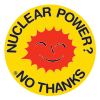| Anti-nuclear movement |
|---|
 |
| By country |
| Lists |
The anti-nuclear movement in the Philippines aimed to stop the construction of nuclear power facilities and terminate the presence of American military bases, which were believed to house nuclear weapons on Philippine soil. Anti-nuclear demonstrations were led by groups such as the Nuclear-Free Philippines Coalition (NFPC) and No Nukes Philippines. Coalitions argued that American bases in the Philippines perpetuated nuclear threats from other opponent nations of the United States, and that nuclear testing was transpiring in these bases. The nuclear threats and the bases also represented foreign intervention from the United States, which was a staunch issue among nationalists.[1]
A focal point for protests in the late 1970s and 1980s was the proposed Bataan Nuclear Power Plant (BNPP), which was built by ousted President Ferdinand Marcos but never operated. The NFPC was formed by Senator Lorenzo M. Tañada, considered the father of the anti-nuclear movement in the Philippines, to stop the opening of the power plant, which it succeeded in pursuing. The Bataan nuclear project was criticized for being a potential threat to public health and for risks associated with the plant being located in an earthquake-prone location on the Bataan Peninsula. The power plant was also less than 180 kilometers away from Metro Manila, thus implicating multiple economic centers and regional sectors.[2]
The anti-nuclear movement campaigned to remove foreign military bases in the Philippines. In 1991, the Philippine Senate voted to reject a new bases agreement treaty with the US, after which Tañada stood up from his wheelchair and was greeted with applause. The US left behind tons of toxic waste after its withdrawal and anti-nuclear campaigners provides assistance for the bases' cleanup.[2] The former bases are now profitable tourist sites in the Philippines, such as the Subic Naval Bay in Subic and the Clark Air Base in Clark, Pampanga, which is a legacy of the anti-nuclear movement.[3]
The movement continues to face challenges as attempts have been made to open the abandoned Bataan Nuclear Power Plant. In 2017 Korea Hydro & Nuclear Power Co. Ltd. (KEPCO) and Russia's Rosatom offered to negotiate to rehabilitate the plant. Opposition to the nuclear plant immediately responded and quickly raised concerns on long-term disposal of highly toxic waste, safety and health issues, reliance on imported uranium, the high cost of decommissioning, and other adverse effects.[4][5][6]
- ^ Parameswaran, Prashanth. "Southeast Asia's Nuclear Energy Future in the Spotlight With Philippines Debate Revival". Retrieved 2020-09-27.
- ^ a b Yok-shiu F. Lee; Alvin Y. So (1999). Asia's Environmental Movements: Comparative Perspectives. M.E. Sharpe. pp. 160–161. ISBN 978-1-56324-909-9.
- ^ "SUBIC TRAVEL GUIDE with Budget Itinerary 2020". Retrieved 2020-09-27.
- ^ "Philippines looking at nuclear revival to meet energy needs". The Financial Express. 2018-05-23. Retrieved 2018-06-21.
- ^ Domingo, Ronnel W. (November 20, 2017). "Nuke plant rehab, revival opposed". Inquirer. Retrieved 2018-06-21.
- ^ Agaton, Casper Boongaling (2019). A Real Options Approach to Renewable and Nuclear Energy Investments in the Philippines. Germany: Logos Verlag Berlin GmbH. p. 54. ISBN 978-3-8325-4938-1.
